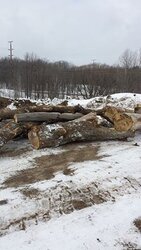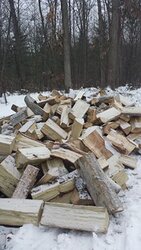I'm figuring there's some hard earned time saving tips to efficient wood collection that you pick up simply from doing it so long...so, as a relative newbie, let's hear 'em!
I've had my father in law lending me a hand recently and that has obviously doubled my productivity but today we finally hit the point in snow depth where I couldn't get my old Jeep Cherokee and trailer past the horse pasture and into the woods. So, instead we cut, split and stacked mini stacks by the dead falls we've been cleaning up and it was amazing how fast we tore through things. It was so obvious but not having to load and haul the wood allowed us to focus on getting the most from having the saw running hot and the shoulders warmed up for the splitting maul.
Anyway, what do all you wood'geniuses do to speed up or maximize the time you have to grow your stacks for the next year?
I've had my father in law lending me a hand recently and that has obviously doubled my productivity but today we finally hit the point in snow depth where I couldn't get my old Jeep Cherokee and trailer past the horse pasture and into the woods. So, instead we cut, split and stacked mini stacks by the dead falls we've been cleaning up and it was amazing how fast we tore through things. It was so obvious but not having to load and haul the wood allowed us to focus on getting the most from having the saw running hot and the shoulders warmed up for the splitting maul.
Anyway, what do all you wood'geniuses do to speed up or maximize the time you have to grow your stacks for the next year?
Last edited:







